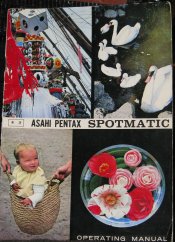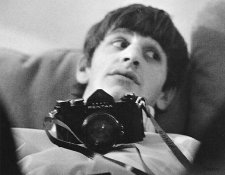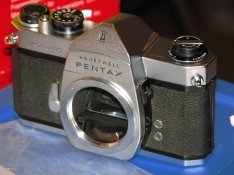David Lyga
Member
In late 1964 the Spotmatic was (finally!) released into the consumer marketplace after four years of R&D. Judging (in retrospect), the stunning success of this SLR was testament to its build quality, ergonomics, and simplicity of design (which demanded rigorous engineering). I have enclosed a couple of pages from the original operating manual.
I do have one question that I cannot find an answer to. Recently I got a 'used' body that is practically new. Everything works, but, of course, I had to clean out the prism area because I do not like dust. Also, one of the strap lugs was loose and its internal screw had to be tightened. Removing the top on this one was a bit different.
I believe that this one was one of the first in formal production because something about it was quickly discontinuted. On the upper SIDE, near the film advance lever, is a chrome screw holding the top to the body. (On subsequent models this chrome screw was placed on TOP, right next to (and partially underneath) that film advance lever.) But what frustrated me this time was the fact that the frame-counter wheel was tensed by a VISIBLE, long, circular spring right under that film-counter wheel. Subsequent models did away with this spring location, (I believe, because of the impediment it caused for removing the top), by placing that spring safely underneath anything that required its removal when taking off the top cover. I had a big problem re-instating that frame-counter spring when I put the top back on and was prepared to sacrifice the frame-counter in return for having a clean prism area. But, after a night's rest, I re-examined the situation and succeeded this morning with everything intact. Also, another indicator of the difference between this model and subsequent ones: the mirror cannot be fully raised by a finger before firing the shutter.
Question: am I correct in stating that this had to be an initial production model? And that that situation was remedied with subsequent models? - David Lyga
I do have one question that I cannot find an answer to. Recently I got a 'used' body that is practically new. Everything works, but, of course, I had to clean out the prism area because I do not like dust. Also, one of the strap lugs was loose and its internal screw had to be tightened. Removing the top on this one was a bit different.
I believe that this one was one of the first in formal production because something about it was quickly discontinuted. On the upper SIDE, near the film advance lever, is a chrome screw holding the top to the body. (On subsequent models this chrome screw was placed on TOP, right next to (and partially underneath) that film advance lever.) But what frustrated me this time was the fact that the frame-counter wheel was tensed by a VISIBLE, long, circular spring right under that film-counter wheel. Subsequent models did away with this spring location, (I believe, because of the impediment it caused for removing the top), by placing that spring safely underneath anything that required its removal when taking off the top cover. I had a big problem re-instating that frame-counter spring when I put the top back on and was prepared to sacrifice the frame-counter in return for having a clean prism area. But, after a night's rest, I re-examined the situation and succeeded this morning with everything intact. Also, another indicator of the difference between this model and subsequent ones: the mirror cannot be fully raised by a finger before firing the shutter.
Question: am I correct in stating that this had to be an initial production model? And that that situation was remedied with subsequent models? - David Lyga
Attachments
Last edited by a moderator:






















